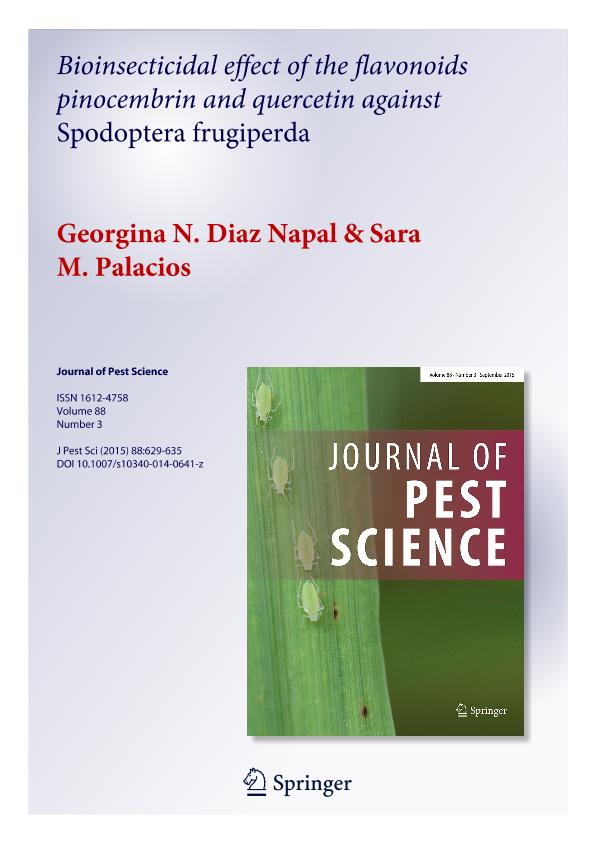Artículo
Bioinsecticidal effect of the flavonoids pinocembrin and quercetin against Spodoptera frugiperda
Fecha de publicación:
09/2015
Editorial:
Springer Heidelberg
Revista:
Journal of Pest Science
ISSN:
1612-4758
e-ISSN:
1612-4766
Idioma:
Inglés
Tipo de recurso:
Artículo publicado
Clasificación temática:
Resumen
Flavonoids function in many aspects of plant–insect interactions, but the responses of insects to these compounds vary greatly. In this study, we determined the effects of two widely distributed flavonoids, pinocembrin and quercetin, on the feeding behavior, survival, and development of the fall armyworm Spodoptera frugiperda J.E. (Smith) (Lepidoptera: Noctuidae). In a choice test, S. frugiperda larvae strongly rejected leaves treated with pinocembrin at concentrations of 10, 50, or 100 μg/cm2. Larvae fed normally on leaves treated with quercetin at 10 and 50 μg/cm2, but showed 57 % deterrence when fed on leaves treated with 100 μg/cm2 quercetin. At concentrations of 0.01–1 µg/cm2, pinocembrin and quercetin functioned as phagostimulants for S. frugiperda. In a multiple-choice experiment, S. frugiperda larvae preferred to consume untreated leaves or those treated with 0.1 µg/cm2 pinocembrin, but rejected leaves treated with 5–50 µg/cm2 pinocembrin. In a no-choice feeding experiment, larvae fed on leaves treated with 5 and 50 μg/cm2 pinocembrin consumed less than those fed on leaves treated with 0.1 and 1 μg/cm2 pinocembrin or untreated leaves. Pinocembrin at 1–50 μg/cm2 negatively affected larval weight and survival, thus showing a toxic effect. In contrast, leaf consumption and larval weight were not significantly affected by quercetin at 0.1, 1, 5, and 50 μg/cm2, and mortality rates only slightly increased. Because of its dual activity, pinocembrin could be used for insect control in a stimulo-deterrent diversionary strategy: the same compound could promote both stimulate (low doses) and deter insect activity (high doses).
Palabras clave:
Antifeedant
,
Flavonoids
,
Lepidoptera
,
Noctuidae
,
Pinocembrin
,
Quercetin
Archivos asociados
Licencia
Identificadores
Colecciones
Articulos(CCT - CORDOBA)
Articulos de CTRO.CIENTIFICO TECNOL.CONICET - CORDOBA
Articulos de CTRO.CIENTIFICO TECNOL.CONICET - CORDOBA
Citación
Diaz Napal, Georgina Natalia; Palacios, Sara Maria; Bioinsecticidal effect of the flavonoids pinocembrin and quercetin against Spodoptera frugiperda; Springer Heidelberg; Journal of Pest Science; 88; 3; 9-2015; 629-635
Compartir
Altmétricas




